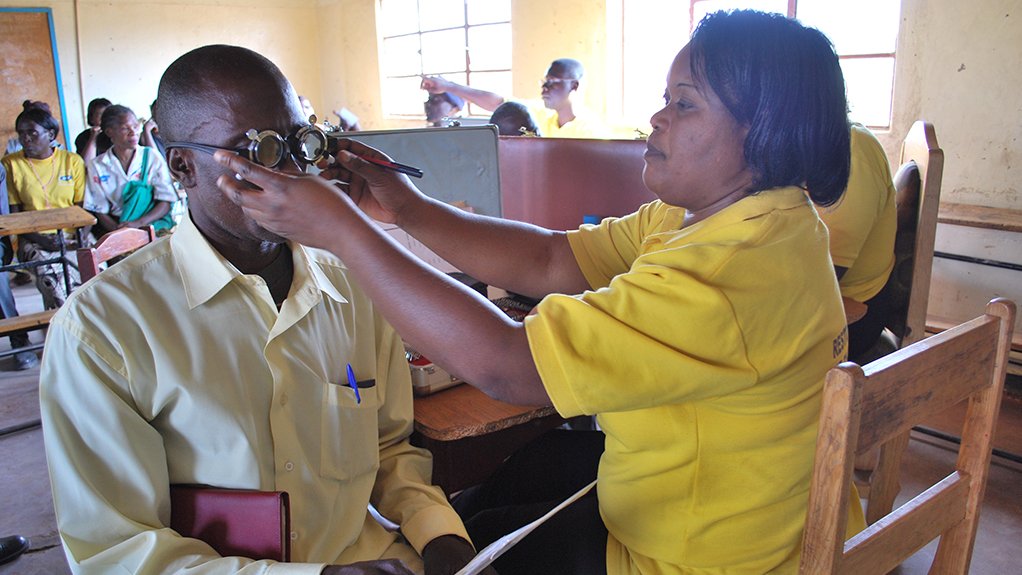New revolutionary glaucoma treatment developed in South Africa
South African medical innovation company Liqid Medical has designed a novel ocular implant called the OptiShunt that uses a simple concept to revolutionise the treatment of glaucoma.
The development of the OptiShunt was funded and supported by the Health Unit of the Technology Innovation Agency (TIA) – an entity of the Department of Science and Innovation (DSI).
The TIA Health Unit aims to accelerate innovation technology development and commercialisation of health products and services in South Africa to increase access to healthcare, reduce healthcare costs, enable local manufacture and reduce imports, while developing health innovation skills.
The OptiShunt was conceptualised by ophthalmologist and Liqid Medical CEO Dr Daemon McClunan after observing the problems caused by glaucoma in patients in rural Northern Cape.
Traditional glaucoma devices drain excess ocular fluid by creating a fluid-filled blister on the surface of the eye, called a bleb. Blebs are uncomfortable, associated with a high risk of complications and failure, and require lifelong follow-up and management by patients and doctors.
This makes traditional glaucoma surgery one of the least cost-effective and most quality-of-life impacting ophthalmic interventions.
Glaucoma is a leading cause of irreversible vision loss worldwide. In South Africa, vision loss is one of the leading causes of disability and accounts for 32% of all disabilities. Glaucoma is caused by a build-up of fluid pressure in the eye, resulting in irreversible damage to the optic nerve.
The OptiShunt uses a unique mechanism that creates a self-regulating system, which in turn provides highly effective pressure control while avoiding the complications and costs associated with traditional devices.
It is designed to limit unsightly bleb formation and the complications that could arise.
Vision loss often leads to unemployment and loss of income, which leads to higher levels of hunger and, ultimately, low standards of living. About 97% of visually disabled people are unemployed, 90% of who are from rural communities. South African women are 40% more likely to be visually disabled than men.
The OptiShunt implant enables access to quality healthcare for vulnerable population groups, particularly those in the public healthcare space. This section of the population has been excluded from the use of traditional glaucoma treatment devices owing to high costs.
Tests conducted have shown that the OptiShunt is 50% more effective than the current gold standard in the treatment of Glaucoma, the TIA said.
“Blindness has dire personal, social, and economic impact, particularly among those at the bottom of the pyramid. The goal for TIA is to identify and support innovations that have the potential to address society’s challenges. The success of OptiShunt would enable access to quality healthcare at a reduced cost with much better clinical outcomes,” said TIA health head Osmond Muroyiwa on April 12.
The use of the OptiShunt halts the progression of blindness and affords the patients an opportunity of a better life and the ability to contribute to the betterment of their families and communities.
Further, the OptiShunt will be manufactured locally and therefore holds the opportunity to create jobs, reduce imports and enable exports.
The next stage in the development of the technology is to conduct regulatory clinical trials. The company is already in the process of obtaining the necessary quality management systems, regulatory approvals and ultimately certification such as CE marking – the European Union’s mandatory conformity marking – and approval by the World Health Organisation.
"By leveraging local resources and industry partners such as the TIA, Liqid Medical [has] reached the major milestone of first in man clinical trials 40% faster and 90% more cost-effectively than our European and American counterparts.
“In South Africa, we have the unique opportunity to combine the innovative drive of a resource-limited setting with the groundbreaking capabilities of highly skilled professionals and cutting-edge technology," McClunan said.
Article Enquiry
Email Article
Save Article
Feedback
To advertise email advertising@creamermedia.co.za or click here
Comments
Press Office
Announcements
What's On
Subscribe to improve your user experience...
Option 1 (equivalent of R125 a month):
Receive a weekly copy of Creamer Media's Engineering News & Mining Weekly magazine
(print copy for those in South Africa and e-magazine for those outside of South Africa)
Receive daily email newsletters
Access to full search results
Access archive of magazine back copies
Access to Projects in Progress
Access to ONE Research Report of your choice in PDF format
Option 2 (equivalent of R375 a month):
All benefits from Option 1
PLUS
Access to Creamer Media's Research Channel Africa for ALL Research Reports, in PDF format, on various industrial and mining sectors
including Electricity; Water; Energy Transition; Hydrogen; Roads, Rail and Ports; Coal; Gold; Platinum; Battery Metals; etc.
Already a subscriber?
Forgotten your password?
Receive weekly copy of Creamer Media's Engineering News & Mining Weekly magazine (print copy for those in South Africa and e-magazine for those outside of South Africa)
➕
Recieve daily email newsletters
➕
Access to full search results
➕
Access archive of magazine back copies
➕
Access to Projects in Progress
➕
Access to ONE Research Report of your choice in PDF format
RESEARCH CHANNEL AFRICA
R4500 (equivalent of R375 a month)
SUBSCRIBEAll benefits from Option 1
➕
Access to Creamer Media's Research Channel Africa for ALL Research Reports on various industrial and mining sectors, in PDF format, including on:
Electricity
➕
Water
➕
Energy Transition
➕
Hydrogen
➕
Roads, Rail and Ports
➕
Coal
➕
Gold
➕
Platinum
➕
Battery Metals
➕
etc.
Receive all benefits from Option 1 or Option 2 delivered to numerous people at your company
➕
Multiple User names and Passwords for simultaneous log-ins
➕
Intranet integration access to all in your organisation



















